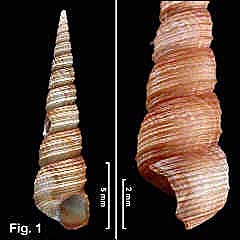|
|
|
|
Haustator cingulifer (Sowerby, 1825) Description: Protoconch of 3 whorls, teleoconch 18 whorls in adult shells Whorls convex, suture impressed. Whorls spirally ribbed; latter whorls sculptured with up to 18 spiral riblets, variable in size and spacing, some beaded. Axial sculpture of sparse growth lines conforming to shape of outer lip sinus. Inner lip of aperture reflected outwards at base; outer lip thin, with moderate sinus, lip usually broken. Aperture higher than wide. Base with numerous unequal threads. Colour off-white to pale brown, with deep chestnut band either above, or below, or on both sides of suture. Operculum circular, corneous. Size: Up to 27 mm in length. Distribution: Indo-West Pacific. In Australia, from Onslow, WA, across northern Australia, to Sydney, NSW. Habitat: In sand, down to about 100 m. Abundant. Comparison: The well rounded whorls, the riblets varying in size and spacing, allied with the chestnut band at the suture, separate this from other species of similar size. In this size range, C. cordismei also has rounded whorls and numerous threads, but there is a rib at the bottom of whorls, and alternating brown and white markings on the ribs. Synonymy: Synonyms include Turritella fascialis Menke, 1830 and Torcula parvus Angas, 1877. Remarks: This species is washed up in huge quantities on beaches in Queensland, especially around Yeppoon, with specimens that show a wide range of colour, sculpture and width occurring together. It is uncommon in northern NSW, becoming rarer to the southern end of the range at about Sydney. Fig. 1: Yeppoon, Queensland, beach washup (DLB5112). |
